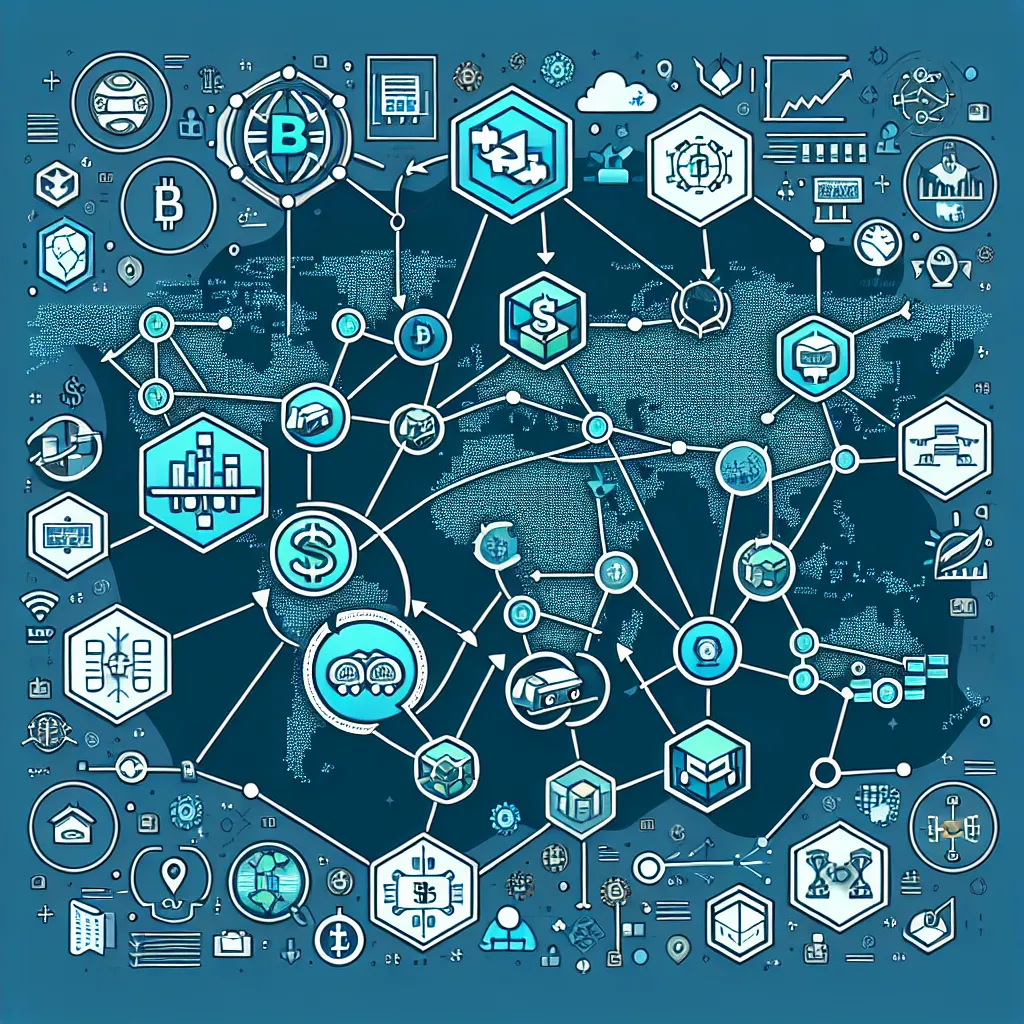As an experienced IELTS instructor, I’m excited to share a comprehensive reading practice test focused on the topic of blockchain technology and its impact on global trade transparency. This test will help you prepare for the IELTS Reading section while exploring an important technological advancement in international commerce.
 Blockchain in global trade
Blockchain in global trade
Introduction to the Test
This IELTS Reading practice test consists of three passages of increasing difficulty, each followed by a set of questions. The passages explore various aspects of how blockchain technology is enhancing transparency in global trade. As you work through the test, pay close attention to the text and apply your reading strategies to maximize your performance.
Passage 1 (Easy Text)
Blockchain Basics in Global Trade
Blockchain technology is revolutionizing the way global trade operates. At its core, blockchain is a decentralized digital ledger that records transactions across multiple computers. This technology ensures that once information is entered, it cannot be altered without the consensus of all parties involved. In the context of international trade, blockchain offers unprecedented levels of transparency and traceability.
One of the primary benefits of blockchain in global trade is its ability to streamline documentation processes. Traditional paper-based systems are often slow, prone to errors, and vulnerable to fraud. Blockchain eliminates these issues by providing a secure, digital platform where all relevant documents can be stored and accessed in real-time. This includes bills of lading, certificates of origin, and customs declarations.
Moreover, blockchain enhances supply chain visibility. Every step of a product’s journey, from manufacturer to end consumer, can be recorded on the blockchain. This level of transparency helps in verifying the authenticity of goods, reducing the risk of counterfeit products entering the market. It also allows for more efficient inventory management and quality control.
The technology also facilitates faster and more secure payments. Smart contracts, which are self-executing contracts with the terms directly written into code, can automate payments once certain conditions are met. This reduces the need for intermediaries and minimizes the risk of payment delays or disputes.
As blockchain continues to evolve, its potential to transform global trade becomes increasingly apparent. By increasing transparency, reducing fraud, and improving efficiency, blockchain is paving the way for a more interconnected and trustworthy global trading system.
Questions 1-5
Do the following statements agree with the information given in the reading passage?
Write:
TRUE if the statement agrees with the information
FALSE if the statement contradicts the information
NOT GIVEN if there is no information on this
- Blockchain technology can be easily modified by any single party involved in a transaction.
- Traditional paper-based systems in global trade are efficient and error-free.
- Blockchain helps in verifying the authenticity of products in the supply chain.
- Smart contracts eliminate the need for all types of intermediaries in global trade.
- Blockchain technology is fully implemented in all aspects of global trade.
Questions 6-10
Complete the sentences below.
Choose NO MORE THAN TWO WORDS from the passage for each answer.
- Blockchain is described as a __ __ that records transactions across multiple computers.
- The technology offers unprecedented levels of transparency and __.
- Blockchain provides a secure platform where documents can be accessed in __.
- The technology allows for more efficient inventory management and __ __.
- Smart contracts can __ payments once certain conditions are met.
Passage 2 (Medium Text)
Enhancing Trade Finance with Blockchain
The integration of blockchain technology into trade finance is transforming the landscape of global commerce. Trade finance, which involves the financing of international trade operations, has long been plagued by inefficiencies and risks. Blockchain offers solutions to many of these challenges, providing a more secure, transparent, and efficient system for all parties involved.
One of the most significant impacts of blockchain in trade finance is the reduction of fraud. Traditional paper-based systems are vulnerable to document forgery and double financing, where the same shipment is used as collateral for multiple loans. Blockchain’s immutable ledger ensures that each transaction is recorded only once and cannot be altered, substantially reducing the risk of fraudulent activities.
Moreover, blockchain technology is expediting the process of trade finance. In conventional systems, the verification and processing of trade documents can take days or even weeks, causing delays in shipments and payments. With blockchain, these processes can be completed in near real-time. Smart contracts automatically execute predefined actions when certain conditions are met, such as releasing payment when goods are received.
The technology also enhances risk assessment capabilities for financial institutions. By providing a comprehensive and transparent view of the entire supply chain, blockchain allows banks to make more informed decisions about credit risks. This improved risk assessment can lead to better terms for trustworthy borrowers and more accurate pricing of financial products.
Blockchain is also democratizing access to trade finance, particularly benefiting small and medium-sized enterprises (SMEs). Traditionally, SMEs have faced challenges in accessing trade finance due to high costs and complex procedures. Blockchain platforms can connect SMEs directly with potential financiers, reducing costs and simplifying the process.
Furthermore, the technology is fostering greater collaboration in the trade ecosystem. Blockchain-based platforms allow multiple stakeholders – including exporters, importers, logistics providers, and financial institutions – to share information securely and in real-time. This increased collaboration leads to better coordination, reduced errors, and improved overall efficiency in trade operations.
However, the adoption of blockchain in trade finance is not without challenges. Regulatory uncertainties, technological standardization issues, and the need for widespread adoption to realize its full potential are some of the hurdles that need to be overcome. Despite these challenges, the potential benefits of blockchain in enhancing transparency and efficiency in trade finance are driving continued investment and innovation in this area.
Questions 11-15
Choose the correct letter, A, B, C, or D.
-
According to the passage, what is one of the main benefits of using blockchain in trade finance?
A) Increased paper documentation
B) Slower processing times
C) Reduction of fraud
D) Higher costs for SMEs -
How does blockchain technology help in risk assessment for financial institutions?
A) By providing a comprehensive view of the supply chain
B) By eliminating all risks in trade finance
C) By replacing credit analysts in banks
D) By increasing the complexity of financial products -
What advantage does blockchain offer to small and medium-sized enterprises (SMEs)?
A) Guaranteed loans from banks
B) Elimination of all trade finance costs
C) Direct connection with potential financiers
D) Automatic approval of all trade finance applications -
Which of the following is NOT mentioned as a challenge for blockchain adoption in trade finance?
A) Regulatory uncertainties
B) Technological standardization issues
C) Need for widespread adoption
D) Resistance from large corporations -
How does blockchain foster collaboration in the trade ecosystem?
A) By eliminating the need for financial institutions
B) By allowing secure real-time information sharing
C) By replacing logistics providers with automated systems
D) By restricting information access to exporters only
Questions 16-20
Complete the summary below.
Choose NO MORE THAN TWO WORDS from the passage for each answer.
Blockchain technology is revolutionizing trade finance by offering solutions to longstanding challenges. It significantly reduces the risk of (16) __ activities by creating an immutable ledger. The technology also (17) __ the process of trade finance, allowing for near real-time verification and processing of documents. Smart contracts automate actions like releasing payment when goods are received. Additionally, blockchain enhances (18) __ __ capabilities for financial institutions by providing a transparent view of the supply chain. The technology is also (19) __ access to trade finance, particularly benefiting SMEs. Despite its potential, blockchain faces challenges such as regulatory uncertainties and the need for (20) __ __ to fully realize its benefits.
Passage 3 (Hard Text)
The Transformative Impact of Blockchain on Global Supply Chains
The integration of blockchain technology into global supply chains represents a paradigm shift in how goods and information flow across international borders. This distributed ledger technology is not merely an incremental improvement but a fundamental reimagining of supply chain management, offering unprecedented levels of transparency, security, and efficiency.
At its core, blockchain’s impact on supply chains stems from its ability to create an immutable and shared record of every transaction and movement within the network. This characteristic addresses one of the most persistent challenges in global trade: the lack of visibility across complex, multi-tiered supply chains. In traditional systems, each participant – be it suppliers, manufacturers, distributors, or retailers – typically maintains its own records, leading to information silos and discrepancies. Blockchain dismantles these silos, creating a single source of truth that all authorized parties can access in real-time.
This enhanced transparency has far-reaching implications. For instance, it significantly mitigates the risk of counterfeit goods entering the supply chain. Each product can be assigned a unique digital identity on the blockchain, allowing its journey to be traced from origin to point of sale. This capability is particularly crucial in industries such as pharmaceuticals and luxury goods, where counterfeiting is not just an economic issue but also a public health and safety concern.
Moreover, blockchain’s transparency fosters greater accountability in ethical and sustainable practices. Consumers and regulators alike are increasingly demanding proof of ethical sourcing and sustainable production methods. Blockchain provides an unalterable record of a product’s journey, including details about its environmental impact, labor conditions, and compliance with fair trade practices. This level of transparency can help companies substantiate their claims about corporate social responsibility and meet the growing consumer demand for ethically produced goods.
The technology also offers significant improvements in supply chain efficiency and cost reduction. Smart contracts, a key feature of many blockchain platforms, can automate many of the manual processes involved in global trade. These self-executing contracts can automatically trigger payments, initiate shipments, or adjust orders based on predefined conditions, reducing administrative overhead and minimizing human error.
Furthermore, blockchain has the potential to revolutionize supply chain finance. The increased transparency and real-time tracking of goods can provide financiers with greater confidence in the underlying assets, potentially leading to more favorable financing terms for businesses. This could be particularly beneficial for small and medium-sized enterprises, which often struggle to access affordable trade finance.
However, the implementation of blockchain in global supply chains is not without its challenges. One significant hurdle is the need for standardization and interoperability. For blockchain to reach its full potential, different systems must be able to communicate seamlessly. This requires not just technological solutions but also agreement on common standards across industries and borders.
Another challenge lies in the scalability of blockchain networks. As the volume of transactions in global trade is enormous, blockchain systems need to be capable of processing these transactions quickly and efficiently. Current blockchain technologies have limitations in terms of transaction speed and energy consumption, issues that are being actively addressed by ongoing research and development.
Data privacy and security concerns also need to be carefully managed. While blockchain is inherently secure due to its distributed nature, the sensitive commercial information stored on these networks must be protected from unauthorized access. Striking the right balance between transparency and confidentiality is crucial for widespread adoption.
Despite these challenges, the potential of blockchain to transform global supply chains is immense. As the technology matures and these hurdles are overcome, we can expect to see a more transparent, efficient, and trustworthy global trading system. This transformation will not only benefit businesses but also consumers and society at large, fostering a more sustainable and equitable global economy.
Questions 21-26
Complete the sentences below.
Choose NO MORE THAN TWO WORDS from the passage for each answer.
- Blockchain technology creates an __ __ of every transaction and movement within the supply chain network.
- In traditional systems, each participant maintains its own records, leading to __ __ and discrepancies.
- Blockchain technology can significantly reduce the risk of __ __ entering the supply chain.
- The transparency provided by blockchain fosters greater accountability in __ and __ practices.
- Smart contracts can help in reducing __ __ and minimizing human error in supply chain processes.
- The implementation of blockchain in global supply chains faces challenges in standardization and __.
Questions 27-33
Do the following statements agree with the information given in the reading passage?
Write:
TRUE if the statement agrees with the information
FALSE if the statement contradicts the information
NOT GIVEN if there is no information on this
- Blockchain technology creates a decentralized record that can be accessed by all authorized parties in real-time.
- The use of blockchain in supply chains eliminates all possibilities of counterfeit goods entering the market.
- Blockchain can help companies prove their claims about corporate social responsibility.
- Smart contracts can completely replace human involvement in supply chain management.
- Blockchain technology has the potential to make trade finance more accessible to small and medium-sized enterprises.
- Current blockchain systems can easily handle the enormous volume of transactions in global trade.
- The implementation of blockchain in supply chains requires balancing transparency with data privacy concerns.
Questions 34-40
Complete the summary below.
Choose NO MORE THAN TWO WORDS from the passage for each answer.
Blockchain technology is transforming global supply chains by offering unprecedented levels of (34) __, security, and efficiency. It creates a (35) __ __ that all authorized parties can access, addressing the lack of visibility in complex supply chains. This enhanced transparency helps in (36) __ the risk of counterfeit goods and promotes accountability in ethical practices. The technology also improves supply chain (37) __ through features like smart contracts, which automate many manual processes.
Additionally, blockchain has the potential to revolutionize (38) __ __, potentially leading to more favorable terms for businesses, especially SMEs. However, the implementation faces challenges such as the need for (39) __ and interoperability, issues with scalability, and concerns about (40) __ and security. Despite these hurdles, blockchain’s potential to create a more transparent and efficient global trading system is significant.
Answer Key
Passage 1
- FALSE
- FALSE
- TRUE
- NOT GIVEN
- NOT GIVEN
- decentralized ledger
- traceability
- real-time
- quality control
- automate
Passage 2
- C
- A
- C
- D
- B
- fraudulent
- expedites
- risk assessment
- democratizing
- widespread adoption
Passage 3
- immutable and shared record
- information silos
- counterfeit goods
- ethical, sustainable
- administrative overhead
- interoperability
- TRUE
- FALSE
- TRUE
- FALSE
- TRUE
- FALSE
- TRUE
- transparency
- single source
- mitigating
- efficiency
- supply chain finance
- standardization
- data privacy
This IELTS Reading practice test provides a comprehensive exploration of how blockchain technology is increasing transparency in global trade. By working through these passages and questions, you’ll not only enhance your reading skills but also gain valuable insights into this innovative technology’s impact on international commerce.
Remember to practice time management and develop strategies for quickly identifying key information in the text. Good luck with your IELTS preparation!
For more IELTS practice materials and tips, check out our related articles on how blockchain technology is changing the financial industry and how cryptocurrency is transforming global finance.


